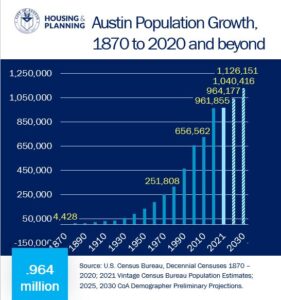 Moving to Austin? Moving within Austin? Let’s define where because Austin doesn’t mean the same thing to everyone anymore.
Moving to Austin? Moving within Austin? Let’s define where because Austin doesn’t mean the same thing to everyone anymore.
Over the years moving to Austin has not only expanded in height in terms of condo towers, but it has spread out in terms of landscape. The city of Austin has a defined border. Geographically, the 2020 U.S. Census defined it as almost 320 square miles. When Austin is referred to as an area, instead of a city, we start to enter a gray zone.
Moving to Austin
There’s the ETJ, the extra-territorial jurisdiction, commonly known as the Austin donut. It is unincorporated land that has an Austin address, but residents have county services because they are outside of the Austin city limits (like the Tesla Giga plant). It’s also worth noting that just because an area of land is outside of the city limits at present, doesn’t mean it won’t be annexed into the city proper at some future juncture.
Things get even grayer with neighboring cities surrounding Austin that make up the MSA but are incorporated in their own right. Buda, Elgin, Lakeway, Leander, Georgetown, Kyle, West Lake Hills, Cedar Park, and Round Rock are cities in their own right. All of these data points make up the greater Austin area and bring out the devil in commuting times.
Austin keeps growing
 The population in Austin has been consistently growing over the years. Estimates from the Census Bureau show we are just shy of the one million mark, at 964,177, and should be over it by 2030. Data is often a number until you hit the road. That’s when all of those people moving here can be seen in the traffic and felt in your back as you sit in the car.
The population in Austin has been consistently growing over the years. Estimates from the Census Bureau show we are just shy of the one million mark, at 964,177, and should be over it by 2030. Data is often a number until you hit the road. That’s when all of those people moving here can be seen in the traffic and felt in your back as you sit in the car.
It used to take me 40 minutes to drive forty-two miles. On a snow day, I could easily add an hour, maybe even two. If people were snowflakes, Austin would be in a storm.
Take an iDrive
Whether I have a buyer moving to the Austin Round Rock MSA, or simply moving to another area of Austin proper, I always encourage taking a ‘test drive’ at least once and an ‘iDrive’ a few times a week.
An iDrive is an instant drive, you can take from your phone at any point in the day (it’s a term I just made up). Smartphones have apps like Google Maps, Apple Maps, and Waze. No matter what technology you use, current traffic conditions are taken into account when the program is calculating an ETA (estimated time of arrival).
Thinking of buying a house in the middle of Kyle but working in North Austin? Great, change the starting location in the phone to the Kyle house and map your trip to work during your normal commute time in the morning and vice versa in the evening to get a sense of how long that commute is going to take. Remember – you can be anywhere and do this.
Take a Test Dive
If you don’t live in Austin, plan on spending a weekday here to take a test drive, a mock commute mimicking your future flight path. Taking the actual test drive to see if that works for your lifestyle will amount to hours spent where you want them; not waiting to get there.
Stay for a night
Airbnb’s are virtually everywhere these days. What better way to prepare yourself for a new commute than to actually experience it? Stay in an Airbnb or VRBO close to your proposed new ‘home’ from Sunday night to Tuesday and really experience what that commute feels like.
Thinking about making a move to Austin or within Austin in the spring? Now is the to reach out to me and start planning. Search for homes in Austin and all Austin area Central Texas cities here.Austin Home Search
